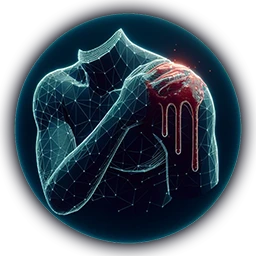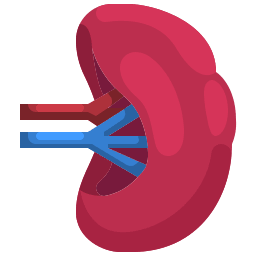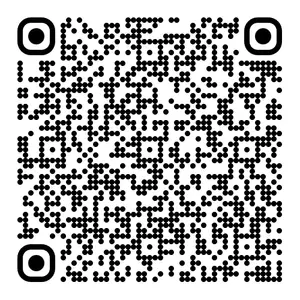AAST Spleen Trauma Grading & Score Calculator
References:
- Zarzaur, B. L., Kozar, R., Myers, J. G., Claridge, J. A., Scalea, T. M., Neideen, T. A., Maung, A. A., Alarcon, L., Corcos, A., Kerwin, A., & Coimbra, R. (2015). The splenic injury outcomes trial: An American Association for the Surgery of Trauma multi-institutional study. The journal of trauma and acute care surgery, 79(3), 335–342. https://doi.org/10.1097/TA.0000000000000782
- AAST (American Association for the Surgery of Trauma) 2018 guideline for splenic injury scoring.
- Organ injury scaling: spleen, liver, and kidney. Moore EE, Shackford SR, Pachter HL, McAninch JW, Browner BD, Champion HR, Flint LM, Gennarelli TA, Malangoni MA, Ramenofsky ML, Trafton PG. J Trauma. 1989 Dec;29(12):1664-6.
- Organ injury scaling: spleen and liver (1994 revision). Moore EE, Cogbill TH, Jurkovich GJ, Shackford SR, Malangoni MA, Champion HR. J Trauma. 1995 Mar;38(3):323-4.
Related Calculators:

More about AAST Spleen Trauma Calculator for Splenic Injury Grading
The AAST Spleen Trauma Calculator is an interactive resource built to help radiologists, emergency medicine providers, and trauma surgeons categorize spleen injuries in patients with blunt abdominal trauma. This calculator utilizes the American Association for the Surgery of Trauma (AAST) Spleen Injury Scale as updated in 2018, emphasizing the use of imaging features, especially those identified by contrast-enhanced CT scans. While this tool is developed independently and is not officially connected to the AAST, it is designed to closely reflect established criteria in the published guidelines. By offering a structured framework for assessment, the calculator supports healthcare teams in standardizing the way splenic injuries are graded and discussed.
The AAST Organ Injury Scale (OIS) provides a uniform method to describe traumatic injuries to a variety of organs. For abdominal trauma, solid organ injuries—particularly to the spleen, liver, and kidneys—are some of the most frequent findings on imaging studies. Accurate grading is essential for communication among trauma teams and can influence the choice between conservative and procedural approaches. Advanced imaging, largely CT, has become central in characterizing these injuries, thus making imaging-based grading an essential aspect of modern trauma care.
Spleen injury grading tools like this one allow for the consistent translation of imaging findings into recognized grades. Incorporating these systems helps ensure that patients are triaged using up-to-date, evidence-based practices while documentation and communication between departments remain precise. The calculator’s design encourages multidisciplinary trauma centers and emergency units to use a reproducible process that aligns with national and international guidelines, adapting as new research and consensus emerge in the literature.
Spleen Injury Grading Calculator
Purpose: To facilitate structured evaluation of spleen injuries in trauma cases by translating CT findings into AAST-defined injury grades. This systematic approach reinforces best practices for imaging-based trauma management.
AAST Spleen Trauma Criteria (2018 Revision)
- Grade I (AIS Severity 2):
- Subcapsular hematoma <10% of surface area
- Parenchymal laceration <1 cm in depth
- Minor capsular tear
- Grade II (AIS Severity 2):
- Subcapsular hematoma 10% to 50% of surface area
- Intraparenchymal hematoma <5 cm in diameter
- Parenchymal laceration 1 cm to 3 cm in depth
- Grade III (AIS Severity 3):
- Subcapsular hematoma >50% of surface area or ruptured
- Intraparenchymal hematoma ≥5 cm or expanding
- Parenchymal laceration >3 cm in depth
- Grade IV (AIS Severity 4):
- Laceration involving segmental or hilar vessels
- More than 25% devascularization of the spleen
- Grade V (AIS Severity 5):
- Completely shattered spleen
- Hilar vascular injury resulting in total devascularization
How to Use the Calculator
- Select the Organ: Confirm that the injury concerns the spleen. Other calculators may be available for liver or kidney trauma.
- Document Imaging Findings: Record the presence and size of hematomas, lacerations, and any signs that suggest vascular injury or devascularization, as seen on CT.
- Calculate the Grade: Enter these findings into the calculator to categorize the splenic injury according to the current AAST criteria.
- Inform Clinical Decisions: Use this grading alongside clinical assessment to support trauma management, including monitoring, intervention, or surgical planning where appropriate.
Clinical Relevance and Application
Research and expert guidelines agree that a structured grading system for splenic injuries can improve communication and streamline decision processes in acute trauma care. Lower grades—such as Grade I and II—frequently correspond with stable clinical presentations and may be candidates for conservative management. Higher-grade injuries or evidence of vascular injury may prompt consideration of interventional radiology or surgery, always in conjunction with the patient’s overall clinical profile. This tool is designed to reinforce a careful, imaging-guided workflow and promote consistent language across multi-disciplinary trauma teams.
Incorporation of this calculator in trauma centers can reduce interobserver variability in the reporting and grading of splenic trauma. By aligning documentation and treatment strategies with up-to-date scientific evidence and national recommendations, it contributes to sustained improvements in patient care protocols and reporting practices across institutions.
Important Notes
This calculator is intended solely to assist with the structured interpretation of spleen injuries and is not affiliated with or officially supported by the American Association for the Surgery of Trauma (AAST). Its use does not replace clinical expertise, judgment, or consultation with trauma specialists. Always consider patient-specific clinical context and ensure reference to the most current trauma management protocols as new literature and guidelines continually emerge.
Frequently Asked Questions (FAQ)
- What does the AAST Spleen Injury Scale measure?
The scale categorizes the severity of spleen trauma based on imaging findings such as hematoma size, laceration depth, and involvement of blood vessels, helping to inform trauma care strategies. - Is this calculator suitable for pediatric patients?
This calculator is based on the general AAST scale, which is primarily validated in adults, but similar grading principles are often used in pediatric trauma with appropriate clinical adjustments. - Do I need contrast-enhanced CT to use this grading system?
The AAST Spleen Injury Scale relies on imaging, usually contrast-enhanced CT, to fully characterize injuries, though clinical judgment remains essential, especially in imaging-limited situations. - Can this calculator determine the best management approach?
The calculator supports grading of the injury but does not make management decisions. Clinical and institutional protocols, as well as multidisciplinary input, are important for optimal care. - Is there a risk in using automated tools for trauma grading?
Automated calculators can support standardized assessment but should only supplement—not replace—expert review of clinical and imaging findings.








You’re wrong, the patient that I’ve demand to calcul the grade have laceration < 3cm and hematoma <5cm so I think grade 2 not 3
Hello Dr. Zoheir,
Thank you for your comment. Per AAST guidelines, if there are multiple injuries, grade should be upgraded to grade III.
Please note this line in the guidelines: “Advance one grade for multiple injuries up to grade III.”
Why does it now state that it’s grade 2 when I choose the same injuries?
Would you please try again and let me know if you still see a grade 2 with these injuries? On my end, the calculator shows a score of 3